Dates of Birth and Death
June 28, 1911-February 8, 1998Birthplace
Elizabeth, New JerseyEducation
- Graduates from Vail Deane School, 1928
- Graduates from Vassar College, with B.A. in English, 1932
- Charter apprentice in Taliesin Fellowship, Taliesin, Wis., with Frank Lloyd Wright, Sept. 1932–April 1933
- Gewerbeschule Basel, Switzerland. Studies construction and design with Hans Bernoulli; history of art, design, architecture, and urban planning with Georg Schmid, 1934–37
Affiliations/Firms
- Charter apprentice, Taliesin Fellowship, Wis., 1932
- Lives and writes in Basel, Switzerland, with her first husband Rudolf Mock, 1934–37
- Part-time assistant to John McAndrew, Curator of Architecture and Industrial Design, The Museum of Modern Art, New York, 1937–41
- Undertakes occasional architectural projects for The Museum of Modern Art, including the publication What Is Modern Architecture?; design and production of Modern Architecture for the Modern School exhibition, and the editing and layout of Philip Goodwin’s book Brazil Builds, written to accompany the 1943 exhibition of that name, 1941–43
- Acting curator of the Department of Architecture, The Museum of Modern Art, New York, 1943–45 Taliesin West Fellowship, Ariz., Feb. 1948–Aug. 1949
- Assistant professor of architectural history, University of Oklahoma, 1949–51
- Research associate, School of Architecture and Urban Planning, Princeton University, 1967–71
Major projects
- Through the Museum of Modern Art, New York, publishes a series of books: What Is Modern Architecture? (coauthor, 1942); Built in USA, 1932–1944 (editor, 1944); If You Want to Build a House (1946); The Architecture of Bridges (circa 1949); Modern Gardens and the Landscape (1964).
- Also at the Museum of Modern Art, New York, assists curator John McAndrew with exhibition publications including Fallingwater (1938); the contemporary architecture section of the Exhibition of American Art in Paris (1938); Useful Objects of American Design Under $10.00 (1940); TVA Architecture and Design (1941); and Regional Building in America (1941).
- As Acting Curator of Architecture, curates exhibitions including Planning the Modern House (1942); Modern Schools (with Rudolf Mock, 1942, circulated as Modern Architecture for the Modern School); Look at Your Neighborhood (with Rudolf Mock and Clarence Stein, 1944, circulated 1944–1950); America Builds (with G. Holmes Perkins, 1944); Built in U.S.A. since 1932 (1944, circulated 1945); Building with Wood (1945); Integrated Buildings: Kitchens, Bathrooms, Storage (with Suzanne Wasson Tucker and Greta Daniel, 1945); A New Country House by Frank Lloyd Wright (1946).
- Her last major project was the compilation and editing of 1932–1982, The Taliesin Fellowship, A Directory of Members (Taliesin, Wis.: The Taliesin Fellowship, 1981).
Awards, honors and press
- “Built in USA, 1932–1944 by Elizabeth L. Mock,” review by Howard Dearstyne in College Art Journal 5, no. 4 (May 1946): 382–84.
- “Built in USA, 1932–1944 by Elizabeth L. Mock,” review by Hugh Morrison in The Art Bulletin 27, no. 2 (June 1945): 162–63.
- “Built in USA, 1932–1944 by Elizabeth L. Mock,” review by Nicholas Pevsner in The Burlington Magazine for Connoisseurs 87, no. 512 (Nov. 1945): 285–86.
- “An Introduction to Modern Architecture by Elizabeth Mock, J. M. Richards,” review by Paul Zucker in The Journal of Aesthetics and Art Criticism 7 no. 2 (Dec. 1948): 168–69.
Location of architect’s archive
Vassar Miscellany News in Vassar College Digital Newspaper Archives. The Museum of Modern Art Archives, New York. Press Releases; Exhibition Records; Alfred Barr and Mortimer Wheeler Papers; Department of Circulating Exhibitions Records; Architecture and Design Correspondence; Bulletin of the Museum of Modern Art; MAID (exhibition-related photographs). Columbia University Library, Avery Index.Related websites
Biography
Written by Juliet Kinchin, The Museum of Modern Art
Although never in practice as an architect, Elizabeth Mock (1911–98; née Bauer, later Kassler) occupied an influential interpretive position between architecture and public in her roles as writer, curator and educator.
Early Life and Education
Born in 1911 in Elizabeth, New Jersey, where she attended the Vale Deane school, Bauer followed her elder sister Catherine to Vassar College. Her talents as an architectural activist and writer were already in evidence in 1932 when, during her senior year, she galvanized a debate among staff and students about what she termed the “appalling” prospective design of a new gymnasium; it was, she argued, an example of archaic and uninspired revivalism, “a stage set construction with its useless excrescences in the shape of fancy peaked roofs and romantic gables.”1 Countering the charge that her viewpoints were “just another example of uninformed, childish and destructive exuberance,” she put the case instead for a modern, multilevel, flat-roofed building in a series of vivid, perceptive, and well-argued articles. Although majoring in English, she had closely followed the debates surrounding modern architecture through her sister Catherine, who at that time was assisting Philip Johnson and Lewis Mumford with the preparation of the housing section of Modern Architecture: International Exhibition (1932) at New York’s Museum of Modern Art. Through their father—New Jersey’s chief highway engineer who had overseen construction of the first cloverleaf interchange in the United States (opened in 1929)—the sisters also had pragmatic insight into developments in modern engineering and construction.
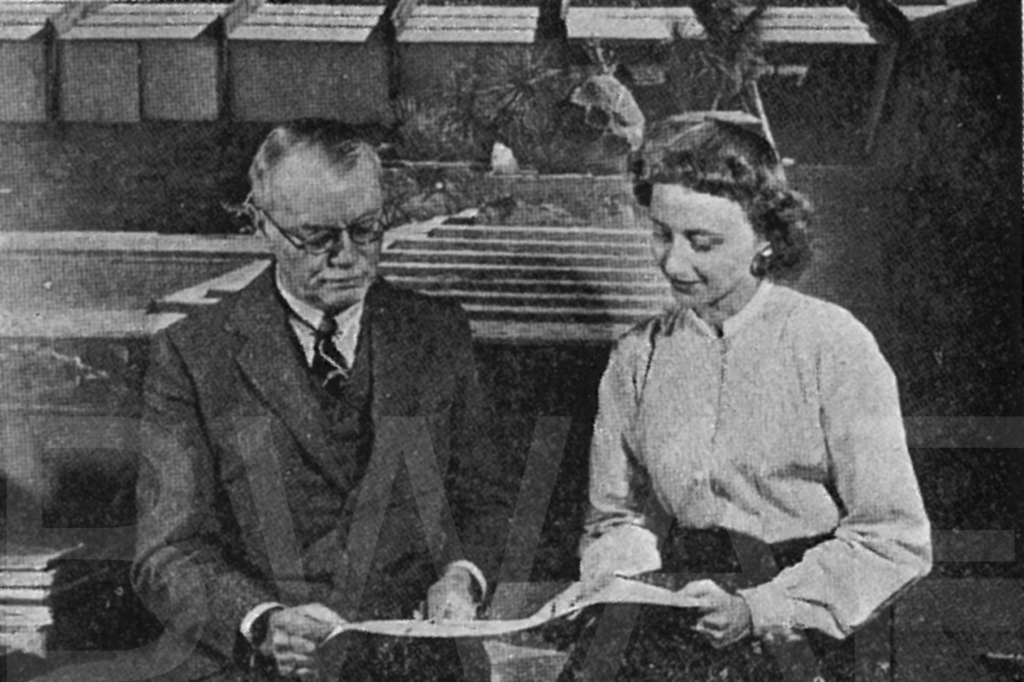
Career in Architecture
After Vassar, without the funds necessary to study at the Bauhaus in Germany, Elizabeth joined the inaugural group of twenty-three apprentices at Frank Lloyd Wright’s Taliesin Fellowship in Wisconsin from September 1932 to April 1933. During this formative period her architectural studies involved spiritual mentoring by Olga and Frank Lloyd Wright rather than formal training. “My most positive gain from Taliesin was a better understanding of Mr. Wright’s work and its implications,” she declared in 1937.2 Through engaging in actual construction work she also acquired some feeling for the properties of wood and stone and for vernacular building methods.
At Taliesin she met and married a fellow apprentice, the Swiss architect Rudolf Mock, and with Frank Lloyd Wright’s blessing the couple moved to Mexico for a short time where they were much impressed by Juan O’Gorman’s schools and the Mexican government’s education program. Observation of the rich variety of architectural responses to landscape, variations in altitude, and available building materials stimulated her interest in regional expressions of architectural identity, an interest further confirmed by contact with Lewis Mumford, her sister Catherine’s mentor and lover. Upon moving to Switzerland, Elizabeth Mock rounded out her architectural studies for a further three years with Hans Bernoulli at the Basel Gewerbeschule. It was here that she consolidated her grasp of contemporary European architecture and discovered her vocation as a curator, inspired by courses with Dr. Georg Schmidt.3 In a letter written to Alfred Barr at MoMA, Mock described Schmidt’s Marxist reading of design as inseparable from the social and economic factors:
Where the subject matter allows, he shows the historical development of tools, methods of construction, and consumers’ requirements, a method of approach that leads to an objective consideration of contemporary problems. All of his exhibitions are organized to illustrate and develop ideas inherent in the subject matter, and he always avoids the merely chronological arrangement. The interest with which the general public attended these exhibitions convinced me that the exhibition can be one of the most efficient ways to put across ideas and information leading to a more intelligent appreciation of modern design.4
This anthropological and socially engaged approach was to inform her ensuing curatorial career at the Museum of Modern Art in New York (from 1937 to 1945), and ran counter to that institution’s overtly aestheticized approach to architecture and design that had been established by two landmark exhibitions, the aforementioned Modern Architecture: International Exhibition (1932) and Machine Art (1934). In this respect she found herself quickly caught up in a schismatic debate surrounding the presentation of architecture and design within the institution.

Impressed by her credentials, Alfred Barr had offered Mock a job in 1937, initially as an assistant to John McAndrew in the Department of Architecture and Industrial Design. It doubtless helped that she had studied with McAndrew at Vassar and that Catherine Bauer had joined the Museum’s advisory committee on architecture in 1936. Betty (as she was known to friends and family) was given special responsibility for the preparation of circulating architecture exhibitions, such as that on Frank Lloyd Wright’s Fallingwater (1938), the contemporary architecture section of the Exhibition of American Art 1609–1938 in Paris (1938), and Useful Objects of American Design Under $10.00 (1940).
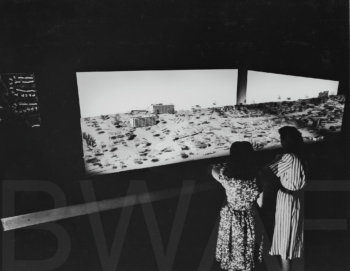
The museum’s correspondence files and a report written shortly before she left MoMA in July 1945 indicate how much of her time was spent acting as a research bureau and general expert on all things architectural. 5 Such work, described as “the most important and the least rewarding,” remained largely invisible to the general public, as did much behind-the-scenes activity that was often credited to more senior curators.6 As was typical at this time, Mock had no choice but to leave her position when she became pregnant in 1941, although she continued to work freelance on MoMA projects, including the book What Is Modern Architecture?, on the design and production of the circulating exhibition Modern Architecture for the Modern School, and the editing and layout of Philip Goodwin’s book Brazil Builds.7 With the mobilization of many men into wartime service, however, a position opened at MoMA for acting curator of architecture in 1943.8 During her brief two-year stewardship, Mock directed and initiated an important and popular string of exhibitions with a strong regionalist message and social agenda, several of them organized in conjunction with her husband, Rudolf Mock, and with Suzanne Wasson Tucker, who was appointed acting curator of industrial design.
Built in U.S.A., 1932–1944 (1944) was particularly successful. It was developed from the architectural section of a larger exhibition, Art in Progress, celebrating MoMA’s fifteenth anniversary. In the accompanying catalogue Mock credited Johnson and Hitchcock’s International Style exhibition of 1932 with directing popular attention “toward the exciting developments which had taken place in Europe.” However, she did not shrink from criticizing its weaknesses, pointing out “the curious assortment of American work” in the selection as well as the absence of urban planning, social programs, and regionalism in the catalogue’s narrative.9 As her opening salvo declared, “Architecture is more than a matter of efficient and beautiful buildings.” Her selection set out to present a friendlier, regionally inflected view of contemporary architecture, and to refocus attention on Frank Lloyd Wright.
She proselytized modern architecture without ever talking down to her audience. Of Mock’s collaboration with J. M. Richards on a revised American edition of An Introduction to Modern Architecture, the critic Paul Zucker observed that “[I]n contrast to the more ponderous European publications on the same topic, more doctrinary in Germany, more emotional-arty in France, an unpretentious, matter-of-fact approach is used to clarify the issue.”10
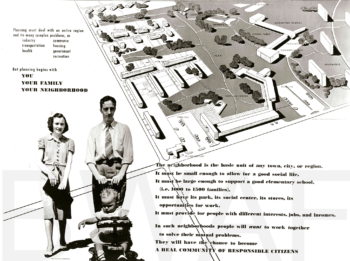
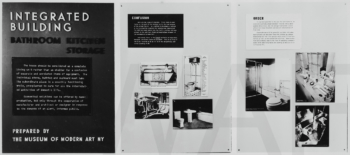
Although they had a didactic role, Mock’s exhibitions like Planning the Modern House (1942), Look at Your Neighborhood (1944–50), and Integrated Buildings: Kitchens, Bathrooms, Storage (1945) were couched in accessible language, and circulated to many venues outside the museum. Informational panels, often in a point-counterpoint format with strong visual imagery and graphic design, were designed to present a rounded argument without any additional materials. Integrated Buildings, for example, dramatized a consideration of the house “as a complete living unit rather than as a shelter for a confusion of separate and unrelated items of equipment” through a series of contrasts between “chaos” and “order,” showing how architects like Buckminster Fuller offered “sensible solutions”—such as prefabrication of mechanical cores for the postwar home—to address “non-sensible practices.”11 Similarly her book If You Want to Build a House (1946) sought to empower individuals to envision and implement the houses and communities of the near future by means of a simply written analysis of problems in home planning, designing, and construction. “It proves that one’s psychological well being depends largely, though unconsciously, upon the character of space, shape, light, materials and color. It offers no recipe for a standard and universal dream house but does show how the modern architect can answer one’s needs—directly, imaginatively, and without prejudice.”12 In trying to propose viable alternatives to the commercialized ribbon development of suburban plots, she worked with local planning councils, industrial manufacturers, and popular magazines such as The Ladies’ Home Journal.
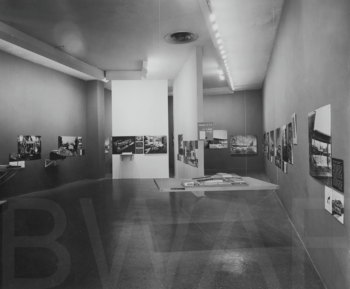
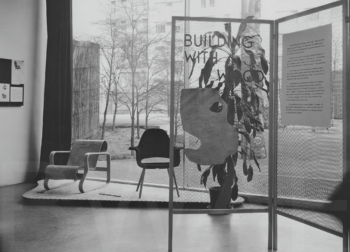
In 1952, just six years after Mock’s Built in the U.S.A., in a move of breathtaking presumption, architectural historian Henry-Russell Hitchcock and Arthur Drexler, the curator of architecture at MoMA, hijacked her title for a new exhibition. Philip Johnson wrote the catalogue preface as if Betty Mock’s iteration of this theme had never existed. Sidestepping any reference to her tenure as acting curator of architecture, he connected the contemporary architectural scene directly back to his own International Style exhibition of 1932. He subsequently dismissed her and her sister Catherine as “do-gooders.”13 There was little love lost between Johnson and Mock, whom he had muscled out of MoMA in 1945. (Johnson’s biographer Franz Schulze, for example, relates how Johnson ignored Mock so totally at a luncheon that she was reduced to tears.14)
After leaving MoMA, Mock rejoined her husband Rudolf, who was working for the Tennessee Valley Authority. Within a couple of years, however, their marriage broke down, and she and her son moved to Taliesin West in Arizona to be with Frank Lloyd Wright and his wife. This restorative spell from February 1948 to August 1949 renewed her commitment to exploring the dialogue between architecture and landscape. “To understand Taliesin West,” she wrote in 1948, “one must give up most of one’s preconceived ideas of building—especially the idea of a precise distinction between interior and exterior, and between walls, roofs and windows. Here inside and outside are one.”15
At Taliesin she completed work on her noted book The Architecture of Bridges (1949), a MoMA project started three years earlier at Philip Goodwin’s suggestion. The impressive list of acknowledgments is a tribute to the contacts she had built up in the early stages of her career, ranging from Sigfried Giedion, Max Bill, and Edward Steichen to Bernard Rudovsky, Henry-Russell Hitchcock, and, above all, Frank Lloyd Wright—a veritable roll call of leading thinkers and champions of modernism across a wide spectrum. In 1951, Betty married another architect, Kenneth S. Kassler, and moved to Princeton, New Jersey, where she continued to write for architectural journals and for MoMA. Returning to a theme first internalized during her brief apprenticeship with Frank Lloyd Wright in Wisconsin, she became preoccupied with exploring the spatial and visual dialogue between architecture and its surroundings. The result was her magisterial 1964 study, Modern Gardens and the Landscape. This same year, she was appointed research associate at the Princeton University School of Architecture and Planning, where she worked until 1971. In 1990, she retired and moved to Lexington, Massachusetts, to be near her daughter. Sadly, reflecting the biases of the architecture establishment, when she died on February 8, 1998, at the age of eighty-six, there was no obituary in The New York Times or any other major American newspaper.
Notes
1 “Vassar buildings, a modern gymnasium,” Vassar Miscellany News 16.39 (April 27, 1932); 16.42 (May 7, 1932); 16.44 (May 14, 1932).
2 Letter to Alfred Barr at The Museum of Modern Art, dated July 30, 1937. Correspondence files, Architecture and Design Study Center, The Museum of Modern Art, New York.
3 Georg Schmidt was the curator of the Basel Gewerbeschule and later the director of the Basel Kunstmuseum. Like his brother, the architect Hans Schmidt, a founding member of ABC (the Swiss-based architectural group linked to constructivist ideas), Georg was a strong supporter of new developments in art and design.
4 Ibid.
5 Department of Architecture, Employee’s Service Summary. Addressed from Mrs. Mock to Miss Ulrich, May 24, 1945. Correspondence files, Architecture and Design Study Center. The Museum of Modern Art, New York.
6 Correspondence and personnel files, Architecture and Design Study Center, passim. The Museum of Modern Art, New York.
7 Press release, September 8, 1943. The Museum of Modern Art Archives, New York.
8 Ibid.
9 Elizabeth Mock, Built in U.S.A., 1932–1944 (New York: The Museum of Modern Art, 1944), 12–13.
10 “An Introduction to Modern Architecture by Elizabeth Mock, J. M. Richards,” review by Paul Zucker in The Journal of Aesthetics and Art Criticism 7 no. 2 (December 1948): 168.
11 “Integrated Building,” internal memo from Mrs. Mock and Mrs. Tucker to Miss Newmeyer dated February 14, 1945, Registrar papers folder 278; Check and Installation List for Integrated Building, Circulating Exhibition folder 278. The Museum of Modern Art Archives, New York.
12 Press release 46107–1, dated January 7, 1946.
13 Philip Johnson speaking in the video Philip Johnson: a Self Portrait (video published by Kent, Conn.: Creative Arts Television Archive ; New York: Cinema Guild [distributor], ©1996).
14 Franz Schultze, Philip Johnson: Life and Work (New York: Alfred A. Knopf, 1994), 174.
15 Elizabeth B. Mock, “Taliesin West,” House and Garden 94 (August 1948), 55.
Bibliography
Books and Articles by Elizabeth (Bauer Mock) Kassler
“Vassar buildings, a modern gymnasium” [series of articles], Vassar Miscellany News 16.39 (April 27, 1932); 16.42 (May 7, 1932); 16.44 (May 14, 1932).
“The Paris Exhibition,” Magazine of Art 30 (May 1937), 266–73.
“What about competitions,” Shelter 3 (November 1938), 26–29.
“Industrial Arts,” Magazine of Art 33 (June 1940), 350–55.
What Is Modern Architecture?, coauthor John McAndrew. New York: The Museum of Modern Art, 1942.
Schools Are for Children: Observations on Elementary School Design, coauthor Rudolf Mock. New York: The Museum of Modern Art, 1943.
Built in U.S.A., 1932–1944. New York: The Museum of Modern Art, 1944. German edition, In USA erbaut, 1932–1944. Wiesbaden: Metopen-Verlag, 1944 and 1948.
Tomorrow’s Small House: Models and Plans. New York: The Museum of Modern Art, 1945.
If You Want to Build a House. New York: The Museum of Modern Art, 1946.
“Modern Architecture Isn’t That Easy,” Vogue 107 (April 15, 1946), 136–37, 187–90.
“Modern Houses: How to Look at Them,” House and Garden 90 (August 1946), 30–47.
Co-author and editor, J. M. Richards, Introduction to Modern Architecture (New York: Penguin Books, 1947 revised edition); Turkish edition, Modern mimarliğa giriş (Ankara, 1966).
“Taliesin West,” House and Garden 94 (August 1948), 52–55.
V.C. Morris [promotional booklet for the San Francisco gift shop designed by Frank Lloyd Wright]. Text by the owners, Edgar Kaufmann, and Elizabeth Mock (San Francisco, after 1948).
The Architecture of Bridges (New York: The Museum of Modern Art, 1949).
[Full text digitized by the Internet Archive in 2013, University of Florida libraries https://archive.org/stream/architectureofbr00kass/architectureofbr00kass_djvu.txt ].
[Book review] “Forms and Functions of Twentieth Century Architecture by Talbot Faulkner Hamlin,” Magazine of Art 46 (March 1953), 139–40.
“Rain on the Roof: Water and Architecture, part 2,” Architectural Record 123 (September 1958), 197–204.
“Why Water,” Architectural Record 125 (May 1959), 189–96.
“Water inside and out,” Architectural Record 60, no.125 (June 1959): 163–74.
Modern Gardens and the Landscape. New York: The Museum of Modern Art, 1964.
“New Towns, New Cities.” In exhibition catalogue The New City; Architecture and Urban Renewal. New York: The Museum of Modern Art, 1967.
“The Sculpture Garden,” MoMA: A Publication for Members of the Museum of Modern Art 4 (Summer 1975): 1.
“The Whole Man,” in In the Cause of Architecture, Frank Lloyd Wright: Essays by Frank Lloyd Wright for Architectural Record, 1908–1952; with a symposium on architecture with and without Wright by Eight Who Knew Him, ed. Frederick Albert Gutheim. New York: Architectural Record, 1975.
1932–1982, The Taliesin Fellowship: A Directory of Members. Taliesin: The Taliesin Fellowship, 1981.
“An Eye on the Moundscape,” Inland Architecture 29 (March–April 1985), 4–5.
“Breaking Down the Man/Nature Interface: Martin Buber and Frank Lloyd Wright,” Landscape 2 (Princeton, N.J., 1985), 28–34.
Secondary literature
Butler, Cornelia, and Alexandra Schwartz, eds. Modern Women: Women Artists at The Museum of Modern Art. New York: The Museum of Modern Art, 2009.
Johnson, Philip, Rosamund Bernier, et al. Philip Johnson: A Self Portrait (video published by Kent, Conn.: Creative Arts Television Archive; New York: Cinema Guild [distributor], 1986).
Lefaivre, Liane, and Alex Tzonis. Architecture of Regionalism in an Age of Globalism: Peaks and Valleys. London: Routledge, 2011.
Oberlander, Peter, and Eva Newbrun. Houser: The Life and Work of Catherine Bauer. Vancouver: University of British Columbia Press, 1999.
Schulze, Franz. Philip Johnson: Life and Work. New York: Alfred A. Knopf, 1994.
Waters, Katrina K. “Elizabeth Bauer Kassler, 1904 [sic]–1998,” Journal of the Taliesin Fellows 23 (Summer 1998): 27–28. [www.mocavo.com › Records › Town Topics (Princeton), February 18, 1998]
Obituary
Katrina K. Waters. “Elizabeth Bauer Kassler, 1904 [sic]–1998,” Journal of the Taliesin Fellows 23 (Summer 1998): 27–28. [www.mocavo.com › Records › Town Topics (Princeton), Feb. 18, 1998]